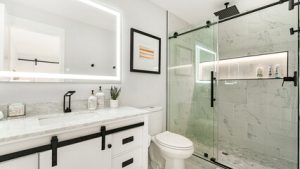Bathroom Remodeling Spring TX is a major step in improving the overall quality of your home. It involves a design phase, demolition, and then installing new materials and decor.

Repainting and upgrading your floor tile are style changes, but moving a toilet, converting a bathtub into a shower or adding recessed lighting fall under the category of layout change.
The layout of a bathroom is one of the most important aspects of its design and function. Whether you are working with an existing space or building from scratch, consider how you and your family will use the room and make sure it meets those needs. For example, if you want to add a soaking tub for long baths, or more storage, plan for those features before starting.
Also, think about how often you’ll be using the space. A bathroom that’s used daily by a family will require different layout options than a master bath for an empty nester. Also, if you’re renovating for resale in the future, consider what features will appeal to potential buyers.
It’s also a good idea to determine your overall design theme before beginning. This will guide your selections and help ensure that your finishes, fixtures, and furniture fit with your vision. You may even want to consider incorporating some energy-saving upgrades into your remodel for long-term savings.
If you’re unsure of what you want your bathroom to look like or how it should function, talk with our professionals about a remodel consultation. We can give you ideas for your project and walk you through what your options are based on the layout of your home, its current features, and your budget.
The demolition phase of a bathroom remodel is a delicate task that requires precision and careful preparation to protect the structural integrity of your home. Our experts can safely and efficiently remove old fixtures, tiles, and flooring to prepare for the new design. They can also upgrade your plumbing and electrical systems, improve ventilation, or even add a window where needed.
Plumbing
Plumbing is a significant component of any bathroom remodel. Professional plumbers have the tools and knowledge to perform any task, from repairing leaks to relocating fixtures to installing new tubs, showers, or sinks. They can also assess the current state of your pipes and advise you on the best options for your needs. For example, older homes often have copper or galvanized steel pipes that may be prone to corrosion and leaks. Replacing these with PEX or other durable materials is a smart investment that will reduce future maintenance and repair costs.
New fixtures and updated plumbing can significantly increase the value of your home. They can also make the space more functional and enjoyable for you to use. If you plan to sell your house in the future, a well-executed bathroom remodel with modern fixtures can speed up the sale process and attract more buyers.
Another important consideration is water conservation. Adding eco-friendly bathroom fixtures like low-flow toilets, faucets, and showerheads can significantly reduce your household water usage and lower your utility bills. Professional plumbers can help you select the right options for your budget and lifestyle.
During a remodel, it’s common to find outdated electrical wiring and switches in your bathroom. Updating these components can improve safety and bring the room up to code standards. For example, it’s important that the bathroom has its own dedicated electrical circuit and that it is GFCI protected. This will prevent tripping breakers and damage to wiring that can occur when multiple appliances are on the same circuit.
Electrical
Electrical upgrades can take your bathroom from functional to fabulous. It’s essential to follow bathroom electrical regulations and codes to prevent safety hazards. It’s also a good idea to use licensed professionals to ensure your work meets the proper standards.
Before any electrical work starts, you should map out where you want the switches and outlets. Doing this ahead of time helps your Electrician Vancouver understand the changes you’re looking for. For example, you should decide if you want to change the placement of the light fixture or switch, or if you’d like to add a vanity light.
Lighting is an often overlooked element in bathrooms, but it can dramatically impact the look and feel of your space. Ambient lighting softens the room, task lighting makes it easier to perform tasks, and accent lighting draws attention to decorative elements. Having the right lighting is especially important in bathrooms, where there is a lot of water and potential for electrocution accidents.
During your remodel, you may need to move electrical wiring or add a new circuit to accommodate new lighting, fans, and other appliances. It’s a good idea to consult your local building department for specific guidelines and requirements that apply to your area.
In most homes, the electrical wiring in a bathroom is on a separate 20-amp circuit from other spaces. This is to protect against accidental electrocution and other electrical hazards, such as surges or fires. Another safety measure is ground fault circuit interrupters (GFCIs), which cut off power quickly to stop electric shock. Adding GFCIs and grounding to your bathroom is an easy upgrade that will improve safety and reduce the risk of electrical emergencies.
Finishes
Bathroom finishes are what give the room its final look and feel. They can include flooring, paint color, lighting fixtures and more. For this reason, it’s important to determine the style you want before selecting finishes. A modern, minimalist design may call for more minimal choices, whereas a traditional or classic style might be best served by more timeless materials. Consider durability and practicality as well. Since bathrooms are high-moisture areas, it’s important to choose finishes that will hold up to moisture and humidity. Some finishes can also become slippery when wet or release volatile organic compounds (VOCs), which can be a health concern for children or elderly family members.
Once the plumbing and electrical rough-ins are finished, framing the walls is a critical step in the remodel. It sets the stage for the installation of new cabinets, showers and more. By completing this phase before moving on to the final finish work, you’ll ensure that your remodel stays on schedule and budget.
The next step is installing the floor and ceiling tiles. These can be tile or natural stone. Choosing a neutral or cool tone will open up the space, making it feel larger and more inviting. Upgrading the lighting can also make a big difference. It’s important to create a layered lighting approach that provides adequate task, ambient and accent lighting. Incorporating smart technology like voice-activated lighting and mirrors that display digital information can also add a high-tech touch and increase resale value.
Budget
One of the most important aspects of a successful bathroom remodel is managing expenses. Careful planning, material selection and obtaining multiple quotes from qualified contractors can help you keep your costs under control.
The cost of a bathroom remodel varies widely depending on the scope of the work, square footage and replacement costs for fixtures and finishings. Adding an extra sink or toilet, for example, increases the overall price of a bathroom remodel. Replacing countertops and flooring is another significant expense that can quickly add up. It’s also important to consider the potential costs of unforeseen complications, such as the need for additional plumbing or electrical work.
Before beginning a bathroom renovation, it’s essential to have a clear idea of what you want to achieve. Whether you prefer a sleek, modern design or a cozy, rustic atmosphere, your new bathroom should reflect your personal style and taste. Choosing quality materials and fixtures is a good way to ensure that your new bathroom is both functional and beautiful.
Another way to cut costs is by upgrading your bathroom to be environmentally friendly. Low-flow shower heads, water-saving faucets and energy-efficient lighting can save you money on your utility bills and reduce your carbon footprint.
Ultimately, the decision to renovate or remodel your bathroom will depend on your budget and your future plans for your home. If you’re looking to sell your property in the near future, a complete remodel may not be worth the investment. However, if you plan to live in your home for many years, a remodel can add significant value and give your bathroom a fresh look.

